Creating your own beef sausage is truly magical. The smell of spices and the sound of sizzling meat fill your kitchen. It’s a way to connect with home cooks from the past.
Making homemade sausage is more than just cooking. It’s a journey where you pick the best ingredients and try new spice mixes. You’ll make sausages that are way better than store-bought ones.
This guide will show you how to make delicious homemade sausage. You’ll learn about choosing the right meat and seasoning. It’s easy and fun, whether you’re new to cooking or have lots of experience.
Table of Contents
Understanding the Art of Homemade Sausage Making
Making your own sausage is a fun journey that turns simple meat into a special treat. It opens up a world of flavors and creativity, unlike store-bought sausages.
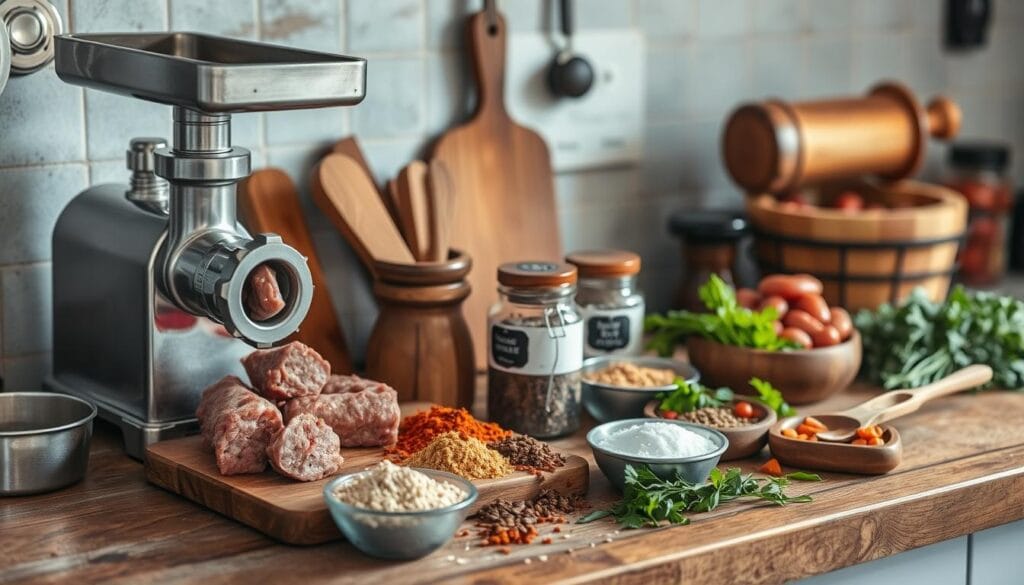
Benefits of Making Your Own Sausage
Homemade sausages bring many benefits. They improve your cooking skills and health. Here are some key advantages:
- Complete control over ingredient quality
- Customizable flavor profiles
- Elimination of artificial preservatives
- Potential cost savings
- Enhanced nutritional value
Essential Equipment for Sausage Varieties
To begin making sausages, you need special tools. Here’s a list of what you’ll need:
| Equipment | Purpose |
|---|---|
| Meat Grinder | Grinding meat to desired consistency |
| Sausage Stuffer | Filling casings with meat mixture |
| Kitchen Scale | Precise ingredient measurements |
| Casings | Natural or synthetic sausage containers |
Quality Control and Food Safety
When making sausages, food safety is key. Use fresh, quality meats and keep them cold. Clean equipment thoroughly and check cooking temperatures for safety.
Ingredients and Required Tools
Making tasty homemade beef sausage begins with picking the right ingredients. You need to choose high-quality items to improve the taste and texture of your sausage.
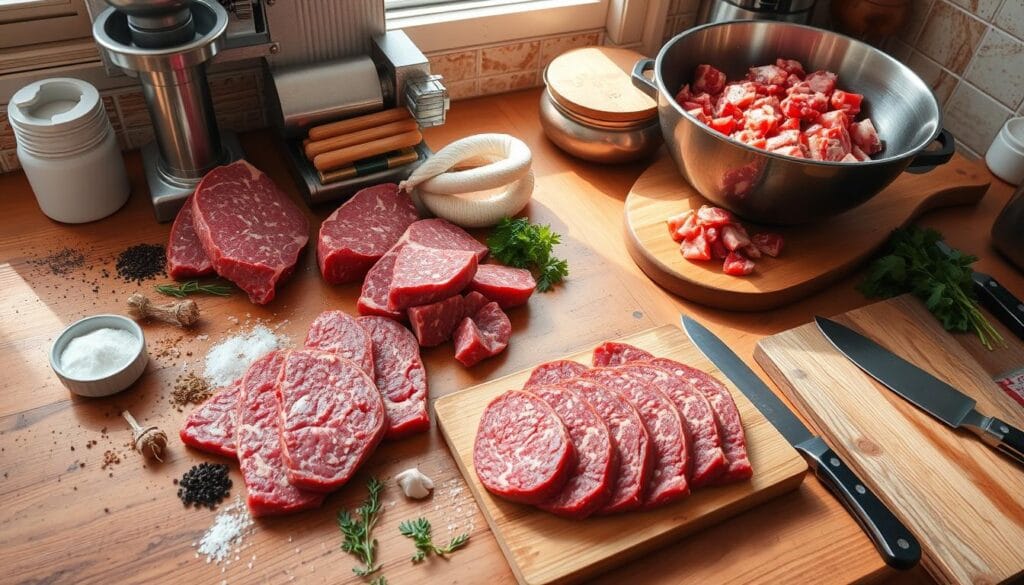
To make great beef sausage, you’ll need certain ingredients and tools. Focus on fresh, top-notch protein sources. These will make your sausage truly special.
Essential Ingredients
- Beef Selection: Pick chuck or sirloin cuts with 20-30% fat content
- Salt (17g per batch)
- Spices:
- White Pepper (3g)
- Paprika (1.5g)
- Garlic (1g)
- Ginger (0.5g)
- Curing salts for safety
- Liquid Smoke (0.5g for enhanced flavor)
Required Tools
- Meat grinder
- Mixing bowls
- Sausage casings
- Kitchen scale
- Refrigerator
| Ingredient Category | Recommended Quantity | Purpose |
|---|---|---|
| Ground Beef | 4 lbs | Primary protein source |
| Curing Salt | 2 Tbsp | Preservation and safety |
| Spices | Varied | Flavor enhancement |
By choosing the right ingredients and tools, you’re ready to make amazing homemade beef sausage. It’s perfect for grilling and other cooking methods.
Preparing Your Beef Sausage Mixture
Creating the perfect beef sausage starts with understanding the critical elements of mixture preparation. Whether you’re exploring what is beef sausage or diving into homemade cured meats, the right technique makes all the difference.
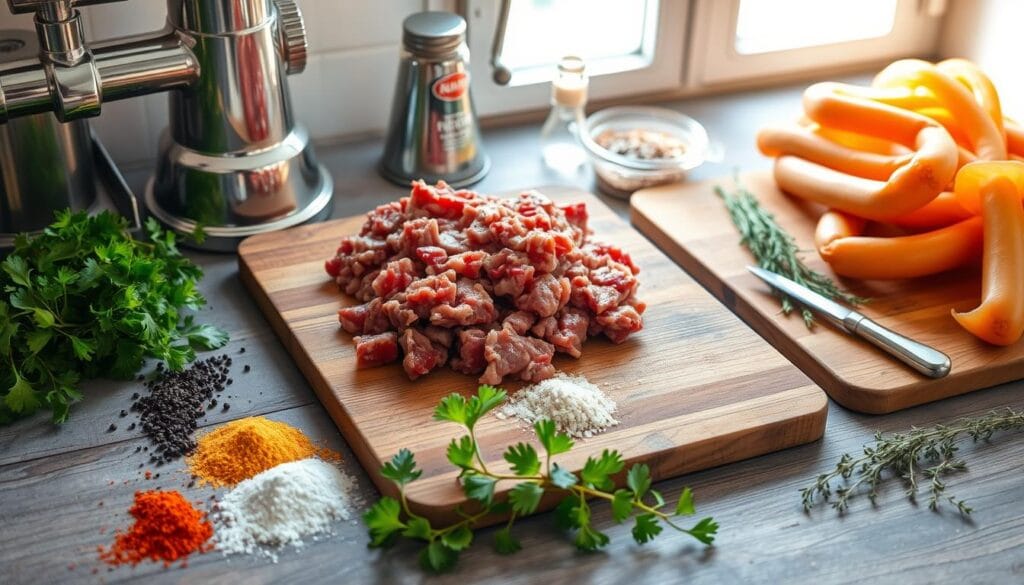
Selecting the Right Meat-to-Fat Ratio
The secret to juicy, flavorful sausages lies in your meat-to-fat ratio. Experts recommend a 75%-85% lean meat to fat combination. This balance ensures your sausage remains moist and packed with flavor.
- Ideal ratio: 80/20 lean-to-fat proportion
- Choose high-quality ground beef with visible fat marbling
- Avoid extremely lean meat to prevent dry sausages
Grinding Techniques for Perfect Texture
Proper grinding is key for the ideal sausage consistency. Keep your meat and equipment cold during the entire process. This helps maintain texture and prevents bacterial growth.
| Grinding Tips | Recommended Practice |
|---|---|
| Equipment Temperature | Refrigerate grinding tools and meat |
| Grinding Speed | Slow and consistent |
| Meat Preparation | Cut into small, uniform cubes |
Proper Seasoning Methods
Seasoning transforms your beef into a delectable sausage. Use approximately 2 tablespoons of seasoning per pound of meat. This ensures even distribution for maximum flavor.
- Mix dry spices thoroughly before adding to meat
- Blend seasonings gently to avoid overworking the meat
- Taste test a small patty to adjust seasoning
Your homemade beef sausage mixture is now ready for the next exciting step in your culinary adventure!
Perfect Spice Blend for Beef Sausage

Making the perfect spice blend is key for standout sausages. Your homemade beef sausages can be a tasty, healthier choice. This is thanks to choosing the right seasonings carefully.
The best spice mix includes classic and strong flavors. Here’s a suggested blend for beef sausages:
- 2 tablespoons garlic powder
- 2 tablespoons onion powder
- 2 tablespoons salt
- 4 teaspoons black pepper
- 1 tablespoon paprika
- 1.5 teaspoons dried fennel
When thinking about healthier sausages, pick fresh ingredients. Herbs and spices boost nutrition and add rich flavors.
| Seasoning | Amount per Pound of Meat | Flavor Profile |
|---|---|---|
| Garlic Powder | 2 tbsp | Robust, Pungent |
| Paprika | 1 tbsp | Mild, Slightly Sweet |
| Black Pepper | 4 tsp | Sharp, Spicy |
Keep your spice blend in a sealed container for up to 6 months. Try different amounts to find your favorite mix!
Step-by-Step Mixing Process
Making the perfect beef sausage needs careful mixing. Whether you’re curious about beef sausage and kielbasa or looking into halal cooking, mastering mixing is key for tasty results.
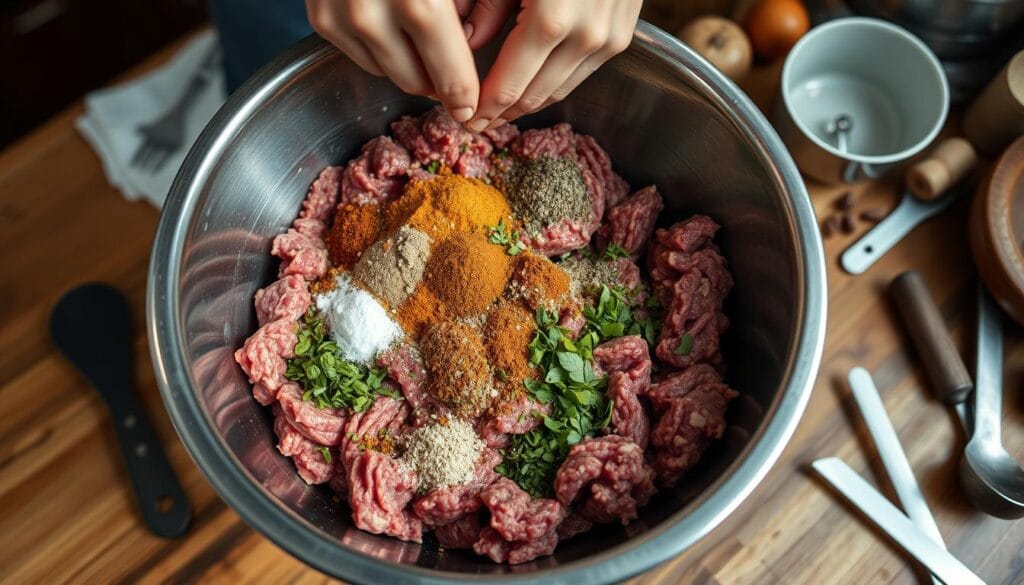
Temperature Control During Mixing
It’s important to keep your meat cold when making beef sausage. Cold temperatures stop fat from melting. This keeps the sausage’s texture and taste just right. Use cold ingredients and work fast for the best results.
- Chill meat and equipment before mixing
- Work in a cool environment
- Use gloves to minimize heat transfer
Testing Seasoning Levels
Yes, Muslims can eat beef sausage! When making halal beef sausage, it’s vital to test the seasoning. Make a small test patty to check the flavor before stuffing the whole mix.
| Seasoning Test Method | Steps |
|---|---|
| Small Patty Test | Cook a tiny amount in a pan to taste |
| Flavor Adjustment | Add more salt or spices as needed |
Achieving the Right Consistency
Mix your beef sausage ingredients just until combined. Don’t overwork the meat, as it can make the sausages tough. Use clean hands or a sturdy tool to spread the seasonings evenly.
- Mix gently and quickly
- Avoid excessive handling
- Aim for uniform spice distribution
Pro tip: If the mix feels too dry, add a bit of cold water. This helps with lubrication and binding.
Stuffing and Casing Techniques
Mastering stuffing and casing techniques is key when making homemade beef sausage. You can buy beef sausage meat or make it yourself for real charcuterie delicacies.
Before you start stuffing, prepare your casings well. Here are important steps for making great sausages:
- Rinse natural casings thoroughly with cold water
- Soak casings in water for 30 minutes to ensure flexibility
- Drain and pat dry before use
For those into charcuterie delicacies, here are some expert tips:
- Use a dedicated sausage stuffer for consistent results
- Avoid air pockets by slowly and carefully filling casings
- Twist links at regular intervals for uniform appearance
Pro tip: If traditional casings aren’t your preference, you can create sausage patties or use the meat in various recipes.
Texas BBQ traditions say keep fat content between 20-30% for the best flavor. This makes your homemade beef sausage juicy and tasty.
Cooking Methods and Times
Learning different cooking techniques is key to making tasty barbecue essentials like smoked sausages. Whether you love grilling or try other methods, knowing the right way can make your beef sausage amazing.
Each cooking method has its own benefits for making your homemade beef sausages. The trick is to keep the right temperature and use the right technique for juicy, tasty results.
Grilling Techniques
Grilling is the best way to make smoky, tasty sausages. Here are some important tips:
- Preheat grill to medium heat (around 350°F)
- Cook sausages for about 15 minutes
- Rotate every 3-4 minutes for even charring
- Make sure the internal temperature is 160°F
Pan-Frying Guidelines
If you don’t have a grill, pan-frying is a great alternative for smoked sausages:
- Use medium-low heat to avoid burning
- Add a little oil to the pan
- Cook for 10-12 minutes, turning now and then
- Check the internal temperature is 160°F
Baking Directions
Baking is a healthier option that’s easy:
- Preheat oven to 375°F
- Put sausages on a baking sheet
- Bake for 25-30 minutes
- Flip halfway through
| Cooking Method | Cooking Time | Temperature |
|---|---|---|
| Grilling | 15 minutes | 350-400°F |
| Pan-Frying | 10-12 minutes | Medium-Low |
| Baking | 25-30 minutes | 375°F |
Pro tip: Always use a meat thermometer to ensure your sausages reach the safe internal temperature of 160°F, guaranteeing both flavor and food safety.
Storage and Preservation Tips
Storing your homemade processed meats right keeps them fresh and tasty. Knowing how to store them well helps avoid waste. This way, your beef sausages stay good for a longer time.
For short-term storage, refrigeration is key. Fresh, uncooked sausages need to be in an airtight container. They should be eaten within 1-2 days. Cooked sausages can stay fresh for 3-4 days in the fridge, kept at 40°F (4°C) or below.
Freezing Guidelines
Freezing makes your sausages last longer. Here’s how to freeze them right:
- Wrap each sausage tightly in plastic wrap or foil
- Put the wrapped sausages in freezer-safe bags
- Try to remove as much air as you can to avoid freezer burn
- Write the freezing date on the bags
Frozen sausages can keep well for up to 2 months. To thaw, let them sit in the fridge for 24-48 hours before using.
| Storage Method | Fresh Sausages | Cooked Sausages |
|---|---|---|
| Refrigerator | 1-2 days | 3-4 days |
| Freezer | Up to 2 months | Up to 2 months |
Always check for spoilage before eating. If they smell bad, look slimy, or have odd colors, throw them away. Safe storage is essential for enjoying your homemade meats.
Serving Suggestions and Pairings
Homemade beef sausage is great for many meals. It can make your cooking stand out. Your family and friends will love it.
Breakfast Combinations
Begin your day with tasty beef sausage breakfasts. Here are some ideas:
- Sausage and scrambled egg breakfast sandwich
- Breakfast burritos with crumbled beef sausage
- Sausage frittata with fresh herbs
- Hash with diced sausage and roasted potatoes
Dinner Applications
Beef sausage makes dinner special with its rich flavors. Try these dinner ideas:
- Hearty jambalaya with sliced sausage
- Italian sausage pasta with robust tomato sauce
- Sausage-stuffed bell peppers
- Rustic sausage and vegetable skillet
Side Dish Recommendations
Pair your beef sausage with the right sides. They bring out its flavor.
| Side Dish Category | Recommended Pairings |
|---|---|
| Roasted Vegetables | Carrots, sweet potatoes, Brussels sprouts |
| Grains | Quinoa, wild rice, polenta |
| Sauces | Spicy mustard, chimichurri, garlic aioli |
Try these ideas to make the most of your homemade beef sausage. You’ll impress everyone with your cooking.
Nutritional Information and Health Considerations
Beef sausages are a complex protein source that needs careful thought. Whether they are healthier depends on how they are made and the ingredients used.
Homemade beef sausages have some key nutritional points:
- Protein content: 18-20g per 100g serving
- Total calories: 250-300 kcal
- Fat content: 20-22g
- Sodium levels: 500-600mg
Recent studies show health risks with processed meat. Eating too much processed meat might raise dementia risk by about 13%. Cognition-conscious individuals might want to moderate their consumption.
To make beef sausages healthier, try these tips:
- Use lean meat cuts
- Control sodium levels
- Incorporate herbs and spices for flavor
- Balance with vegetable-rich meals
Switching to nuts, legumes, or fish could lower dementia risk by 19-28%. Homemade beef sausages can be part of a healthy diet if eaten wisely.
FAQ
What is beef sausage?
Beef sausage is a meat product made from ground beef and spices. It’s stuffed into casings. You can find it fresh, cured, or smoked. It’s great for breakfast, grilling, or charcuterie boards.
Are homemade beef sausages healthier than store-bought?
Yes, homemade sausages are often healthier. You choose the ingredients. Use quality meat, less preservatives, and control the spice blend. This way, you can make a nutritious version of commercial sausages.
Is beef sausage the same as kielbasa?
No, they are not the same. Kielbasa is a Polish sausage made with pork or a mix of pork and beef. It has a smoky flavor and unique spices. Beef sausage varies in seasoning and preparation.
Can Muslims eat beef sausage?
Muslims can eat beef sausage if it’s halal. This means using meat from a halal source and no pork products. When making homemade sausage, check the meat’s source and preparation.
Can you buy beef sausage meat separately?
Yes, you can buy beef sausage meat from butchers and some stores. But making your own lets you customize flavors and ingredients. Many prefer grinding their own meat for a fresher product.
What are the best cuts of beef for making sausage?
The best cuts are chuck, sirloin, and brisket. They have a good mix of meat and fat. Aim for 80% lean meat and 20% fat for the best taste and texture.
How long can homemade beef sausages be stored?
Uncooked sausages can be refrigerated for 1-2 days or frozen for 3 months. Cooked sausages last 3-4 days in the fridge or 2-3 months frozen. Always use airtight packaging and label with the date.
What are some popular seasoning options for beef sausage?
Popular seasonings include garlic powder, paprika, and black pepper. You can also use fennel seeds, red pepper flakes, and herbs like thyme or oregano. Try different combinations for Italian-style, spicy, or traditional flavors.
Conclusion
Making your own homemade sausage is more than just cooking. It’s an art that connects you to old culinary ways. Your sausage recipe lets you choose the best ingredients. This means you get high-quality, hormone-free meat with just the right amount of fat.
Understanding the right mix of beef and seasonings makes your cooking better. It takes your home cooking to a new level.
Safety and storage are key to making great sausage. Always cook your sausage to 160°F to keep it safe. Store it below 40°F to stop bacteria from growing.
When freezing, use airtight containers and label them well. These steps help you enjoy your homemade sausage safely and deliciously.
Your cooking journey doesn’t stop with making sausage. Try it in breakfast sandwiches, burritos, and skillets. Play with spices and cooking ways like grilling, stovetop, or oven-baking. This way, you can find your own special way of making sausage.
Remember, each batch of sausage is a new chance to show off your creativity in cooking.
The global sausage market is growing fast, expected to hit USD 2.55 billion by 2032. You’re part of this exciting trend. Your homemade sausage stands out because of its quality, flavor, and personal touch.
Keep exploring, learning, and enjoying the tasty results of your cooking. Your homemade sausage is a true reflection of your culinary skills.
Check out more recipes on our website

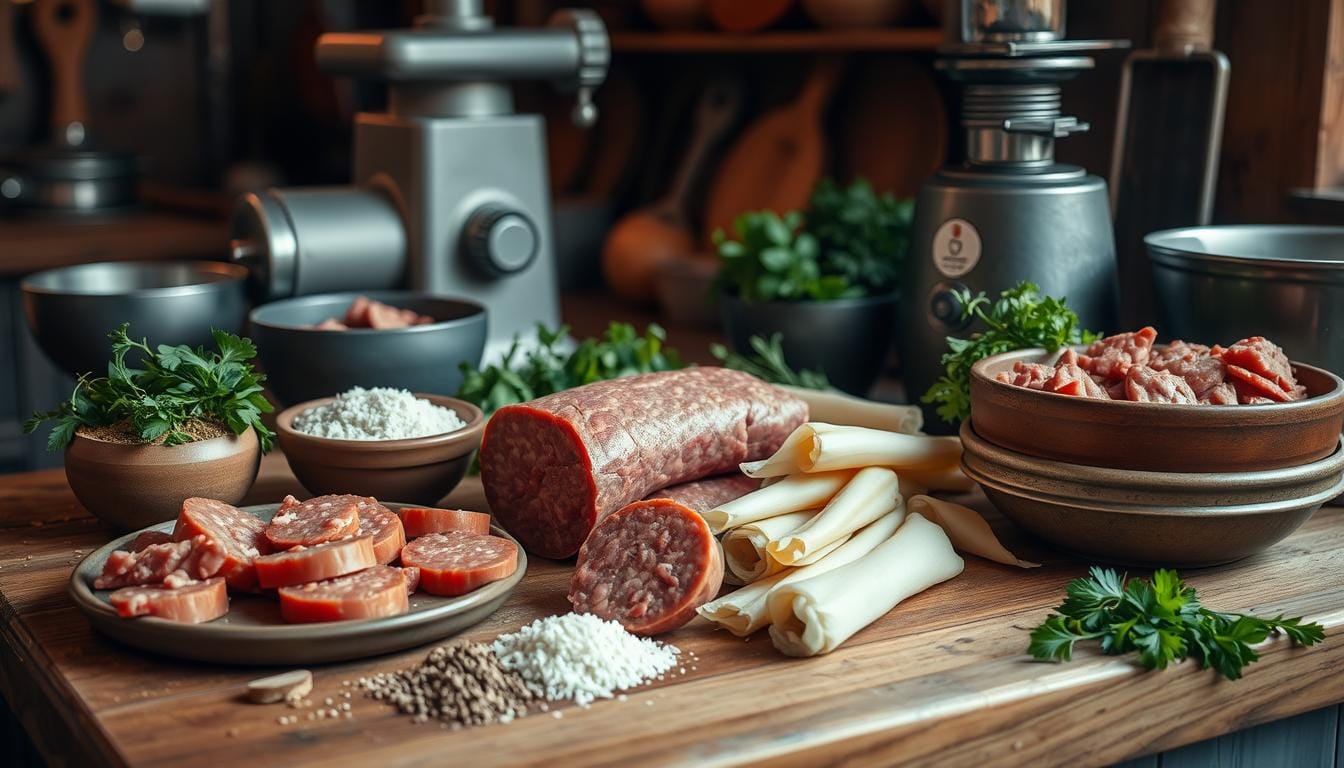

1 thought on “Homemade Beef Sausage Recipe: Easy Cooking Guide 2025”